Seljuk architecture, Nobel and powerful, structurally invented and sophisticated, was neither sudden nor accidental. Rather it was the culminating expressions of a Persian renaissance that had begun in the early tenth century with the Samanids. this renaissance reached its apex under the Seljuks.
Cultural Background :
''Seek ye Knowledge even unto china'' commanded the Prophet Muhammad S.A.W.W and next to prayer, learning was regarded as the most sacred, preferable even to unreasoned piety. The productive stimulation of different, snd often competing, society was steadily enlarging and energizing Islamic culture life and thought. Most significant was the appropriation and preservation of classical Greek culture. Through well-organized translations financed by Caliph Mamun, Greek Philosophy and science Became known in Persia. Galen, Plato, and Aristotle were assiduously studied in all leaders of Persian thoughts.
During the 10th century, however, Persia again produced its own constellation of poets, Philosophers, mathematicians, astronomers, physical scientists, historians, and geographers most of them are brilliant, many of unequaled eminence, all with a high degree of originally, boldness, and cultural breadth. In comparison, the same years in Europe were dark indeed.
By far the most important element in the initiation of the native Persian revival was Firdawsi's poem Saha Nama, completed in 1010. One of the epics, it's entered immediately and permanently into the heart of the nation. In all of his 60,000 couplets he used no more than 984 Arabic expressions, the rest were purely Persian. He restored to the Persians the use of renovated magnificent language, created new confidence and patriotism.
The rulers, a number of the true scholars and even poets, rivaled each other in a patronizing poet, artists, and scholars. The honor of being a patron was regarded as the obligation of royalty and a valid claim to status and public esteem. The libraries of time tell the story of a widely shared culture, in which learning was revered. Sahib ibn Abba, vizir of the Buyids and successful ruler of most Persia before his death in 996, had a vast library of certainly more than 2000 volumes. Each mosque had a collection of books. The cadi of Nishapur designated a house with a library especially for the use of visiting scholars and even supplied them with living expenses. One famous library was complied by Abdul-ad dawla installed in a special building in Shiraz.
Both Buyid and Seljuk periods produced some of the most remarkable textiles ever achieved and the pottery, mostly from Nishapur and Samarkand, is among the finest ever made.
The second half of the 9th century saw the appearance of a number of encyclopedias and histories. The learned profession produced a number of great thinkers, components in many areas: Al Razi, physician, chemist, and physicist whose influence spread to make contained much valuable historical and even archeological material. He created a systematic star catalog, tables, and instruments. mathematics and astronomy were vigorously summarized in a Persian encyclopedia of 976, The key of the sciences, A group called the '' Brethren of sincerity'', published valuable commentaries.
Ibn Sina was a born mathematician, poet, and astronomers who made important contributions to physics and was one of the world's first great figures in medicine and his medical treatise were basic texts at Oxford as late as the 17th century.
Omar Khayyam was also an original philosopher and a great mathematician. He recognized 13 different forms of cubic equation in 1074. Al-Ghazali, a man of intellectual power, deep feeling, and utter dedications, was an outstanding poet and philosopher.
Into highly developed civilizations came the conquering Seljuks, an Iran- Turkish stock, Their leaders already familiar with the Persian culture established in Central Asia.
Stay Connected for more.





amazing info
ReplyDeleteInformative
ReplyDelete